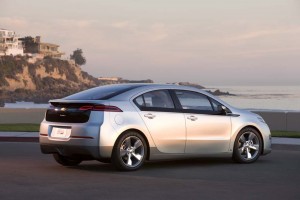Embarrassed by reports that the batteries in several of its Chevrolet Volts caught fire after crash tests, General Motors is fighting back by pointing out that there are more than 215,000 car fires annually in the U.S. involving vehicles fueled by gasoline.
GM is facing an increasingly serious nightmare in the wake of the fires at National Highway Traffic Safety Administration test facilities. While there have been no reports of fires involving Chevy Volt plug-in hybrids owned by the public there are clear signs of concern among potential buyers and several Volt dozen owners have reportedly taken GM up on its offer to buy the vehicles back.
Meanwhile, Congress plans to investigate the issue, House Republicans questioning whether GM and the Obama administration are covering up more serious problems with the Volt.
But GM is fighting back, pointing out that cars fueled with gasoline are also routinely involved in fires. And the automaker has pointed out that after crash testing NHTSA routinely empties vehicle gas tanks. It did so on the Volt but failed to also discharge the plug-in’s batteries as required by the maker’s post-crash protocol.
Britta Gross, director of energy systems at General Motors, said in an interview with Platt’s Energy Review that the maker remains confident in the Volt even after the two battery fires.
Volt delivers fuel efficiency of 37 miles per gallon when using gasoline, along with batteries big enough to accommodate roughly 40-mile round-trip commutes. It charges overnight in about 10 hours at 120-volts, the standard accommodation from a wall socket in American homes, Gross said.
“We’ve got to deal with the limited range on batteries and in the foreseeable future it is very difficult to imagine that we’ll find this miracle battery that does 300 miles and so on,” Gross said.
Even Volt’s relatively small battery pack is enough for more than three of four American commuters, she said. “Can we get 80% of Americans essentially off gasoline, day after day, week after week, month after month? And the data suggests that’s exactly what’s happening with owners of the Volt,” Gross noted.
GM put the smallest battery possible in the Volt to keep the cost down and complements it with gasoline power to make it acceptable to car buyers, Gross said “I think consumers understand there are also about 215,000 gasoline car fires every year and that just gets completely overlooked,” Gross said. “We feel very, very good about this vehicle.”
GM and others automakers are studying the cause of the Volt battery fires. “We’re cooperating; we’re working with the NHTSA to understand what the latent effects are after a severe crash of any electric vehicle. The industry wants to learn as much as possible from any of these events,” she said.
The lithium-ion technology is new and “we’ve had stunning success with the vehicle program,” Gross said, citing how Consumer Reports magazine recently announced that the Volt was the highest-rated vehicle of the year in terms of customer satisfaction.
Meanwhile, despite the NHTSA fires the Insurance Institute for Highway Safety says it will stand behind its 5-star crash rating for the Chevrolet plug-in.
The fire issue illustrates why automakers do not initially produce one million units when launching a vehicle using all-new technology, Gross said. GM expects to sell just over 6,000 Volts this year, which is short of its original goal of 10,000.
Gross also said there is ample electric power in the U.S. to handle demand on the electric grid as the number of electric vehicles on the road increases. GM has been collaborating for five years with 50 utilities and the Electric Power Research Institute to study the issue, Gross said.
“What happens when we scale up to a million vehicles? Do we see major grid issues? Answer: no,” she said. “When the vehicle is plugged into a regular household outlet and charged at 120 volts, it’s only drawing about 1.2 kilowatts (kw)” while a hair dryer typically uses 1.3 or 1.7 kw.” “So it’s a very, very benign load. Even at 240 volts, if you want to step it up and get a faster charge at your home, even then it’s only 3.3 kilowatts. So, that’s well within what a utility would consider an extremely reasonable appliance in a home,” Gross added.


“House Republicans questioning whether GM and the Obama administration are covering up more serious problems with the Volt.”
Well no surprise there. Just another chance for Republicans to take a jab at Obama.